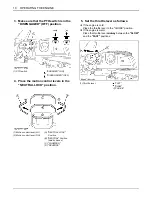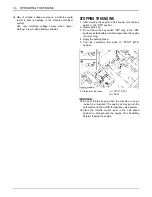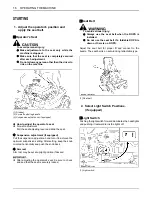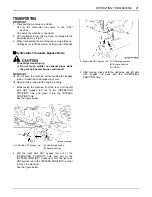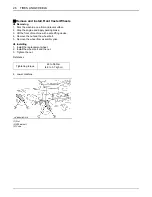
15
OPERATING THE MACHINE
OPERATING THE MACHINE
OPERATING NEW MACHINE
How a new machine is operated and maintained will
determine the life of the machine.
A new machine just off the factory production line has
been tested, but the various parts are not accustomed to
each other, so care should be taken to operate the
machine for the first 50 hours at a slower speed and avoid
excessive work or operation until the various parts
become "broken-in." The manner in which the machine is
handled during the "breaking-in" period greatly affects the
life of your machine. Therefore, to obtain the maximum
performance and the longest life of the machine, it is very
important to properly break-in your machine. In handling a
new machine, the following precautions should be
observed.
B
Changing Lubricating Oil for New
Machines
The lubricating oil is especially important in the case of a
new machine. The various parts are not "broken-in" and
are not accustomed to each other; small metal grit may
develop during the operation of the machine; and this may
wear out or damage the parts. Therefore, care should be
taken to change the lubricating oil a little earlier than
would ordinarily be required.
For further details of change interval hours.
(See "SERVICE INTERVALS" in "MAINTENANCE"
section.)
B
Engine Break-in
After the first 100 hours of operation, change the engine
oil and filter. (See "EVERY 100 HOURS" in "PERIODIC
SERVICE" section.)
B
Machine Break-in
After the first 100 hours of operation, change the transaxle
fluid and oil filter cartridge. (See "EVERY 100 HOURS" in
"PERIODIC SERVICE" section.)
To avoid serious injury or death:
A
Do not operate the mower without the deflector
shield in the down position.
To avoid serious injury or death:
A
The machine relies upon the engine driven
transmission for speed, direction, and motion
control. If the engine is not running, the
machine cannot be driven or controlled.
If the engine stops when operating on a slope,
apply the parking brake immediately to prevent
machine runaway.
A
Do not allow any person other than the driver to
ride on the machine.
A
Do not drive the machine close to the edges of
ditches or banks which may collapse under the
weight of the machine, especially when the
ground is loose or wet.
A
When turning the machine, be sure to reduce
the travel speed and operate motion control
levers carefully.
A
To avoid tip over, operate across slopes, not up
and down. Avoid sudden starts and stops on
slopes. Slow down, and use extra caution when
changing direction on a slope.
Park the machine on a firm and level surface.
A
Watch where you are going at all times. Watch
for and avoid obstacles. Be alert at curbs, near
trees, and other obstructions and hidden
hazards.
A
Do not mow near drop-offs, ditches or
embankments. The mower could turn over if a
wheel is over the edge of a cliff or ditch, or if an
edge caves in.
A
Do not drive machine on streets or highways.
Watch for traffic when you cross roads or
operate near roads.
A
Look to the rear before and when backing.
Make sure the area immediately behind you is
clear of obstructions, holes and small children.
Use extra caution when machine is equipped
with Grass Catcher.
A
Keep bystanders especially children and
animals away from the mowing area.
To avoid personal injury:
A
Clear the work area of objects which might be
picked up and thrown by blades.
A
Do not direct the opening of the chute at
bystanders or animals. Ejected objects may
cause injury. Plan your mowing carefully
before starting operation.
A
Be sure to disengage the PTO and sit on the
operator's seat before starting the engine.










